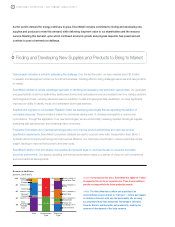Exxon 2007 Annual Report Download - page 18
Download and view the complete annual report
Please find page 18 of the 2007 Exxon annual report below. You can navigate through the pages in the report by either clicking on the pages listed below, or by using the keyword search tool below to find specific information within the annual report.
The Outlook for Energy –
A View to 2030
Our outlook is focused on the world’s rising energy needs
and how we expect these needs to be met. Providing
this energy is not easy or automatic. The challenges
reflect the global scope of the task, as well as substantial
objectives related to economic development, energy
security, and the environment.
The Outlook for Energy summarizes ExxonMobil’s
projections for global energy demand and supply through
2030, and is the result of an ongoing process that has
been conducted for decades. The results underpin our
long-term strategies and investment plans.
PRO G R E S S D R I V E S A G ROW I N G N E E D FO R ENERGY
The world’s economy runs on energy. Future energy use will
be driven by a growing global population that continues to
advance and seek better living standards. Global economic
output, as measured by Gross Domestic Product (GDP),
is likely to increase by close to 3 percent annually through
2030, similar to historical trends.
While growing, the global economy is becoming more energy
efficient. Energy intensity – the amount of energy used per
unit of economic output – has improved significantly over the
past 25 years. The rate of improvement is likely to increase
as advanced technologies are developed and deployed. As
a result, energy intensity in 2030 will be almost 50 percent
below the level of 1980.
Global energy demand – expressed in millions of oil-equivalent
barrels per day – is expected to increase 1.3 percent per
year on average from 2005 to 2030, even with significant
efficiency gains. The vast majority of the demand increase
will be in developing countries, where economies are growing
most rapidly and modern energy supplies are still a precious
commodity for millions of people. While the use of
alternative fuels will continue to grow, oil, natural gas,
and coal will remain the primary sources of energy
throughout the outlook period.
POW E R GENERATION A N D
G ROW I NG E L ECTR I C IT Y DE M A N D S
The largest end-use sector today, and the one with the
greatest volume growth going forward, is power generation.
Both economic development and rising prosperity drive the
demand for electricity.
As developing countries become more prosperous and
billions of people move up the economic curve, demand for
electricity will increase significantly. Meeting this demand will
require strong growth in fuel supplies for power generation.
On a global basis, coal will remain the largest source of
power through the outlook period, although natural gas will
have the largest increase. While more efficient technolo-
gies and cleaner fuels will continue to penetrate the power
generation sector, coal’s predominance will continue to have
significant implications for overall CO
2
emissions.
TR A NSPORTAT ION D E M A N D E XPA N D I N G
The fastest growing sector – and the one most important to
oil demand – is transportation, which includes road vehicles,
ships, trains, and airplanes.
Transportation is an essential part of today’s world – whether
aiding the provision of goods and services, or getting people
to local or distant destinations. Global economic progress,
increasing populations, and rising individual prosperity will
remain strong drivers of transportation demand.
As the number of vehicles continues to rise, energy efficiency
will become increasingly important. Significant gains are
expected to come from evolutionary changes to conventional
engine technologies, along with market penetration of
advanced vehicle technologies.
20301980 2005
Worldwide Economic Output
(trillions of dollars, 2005 dollars)
100
80
60
40
20
Average 3.0%
Annual Growth 2005-2030
20301980 2005
3.0
2.5
2.0
1.5
1.0
0.5
(barrels of oil-equivalent/thousand dollars
gross domestic product, 2005 dollars)
Global Energy Intensity
Annual Change 2005-2030
Average –1.6%
350
300
250
200
150
100
50
(millions of oil-equivalent barrels per day)
Power Generation
Transportation Residential/Commercial
Industrial
Annual Growth 2005-2030
0.7%
1.2%
Average 1.3%
1.7%
1.5%
1980 2005 2030
World Energy Demand by Sector
E X X O N M O B I L C O R P O R A T I O N • 2 0 0 7 S U M M A R Y A N N U A L R E P O R T
16
























